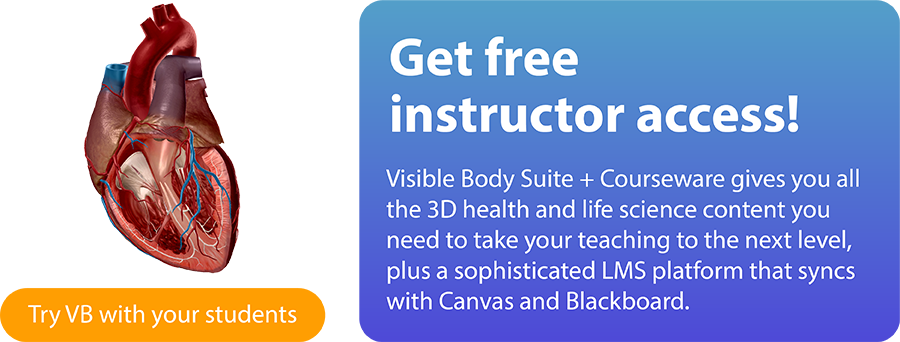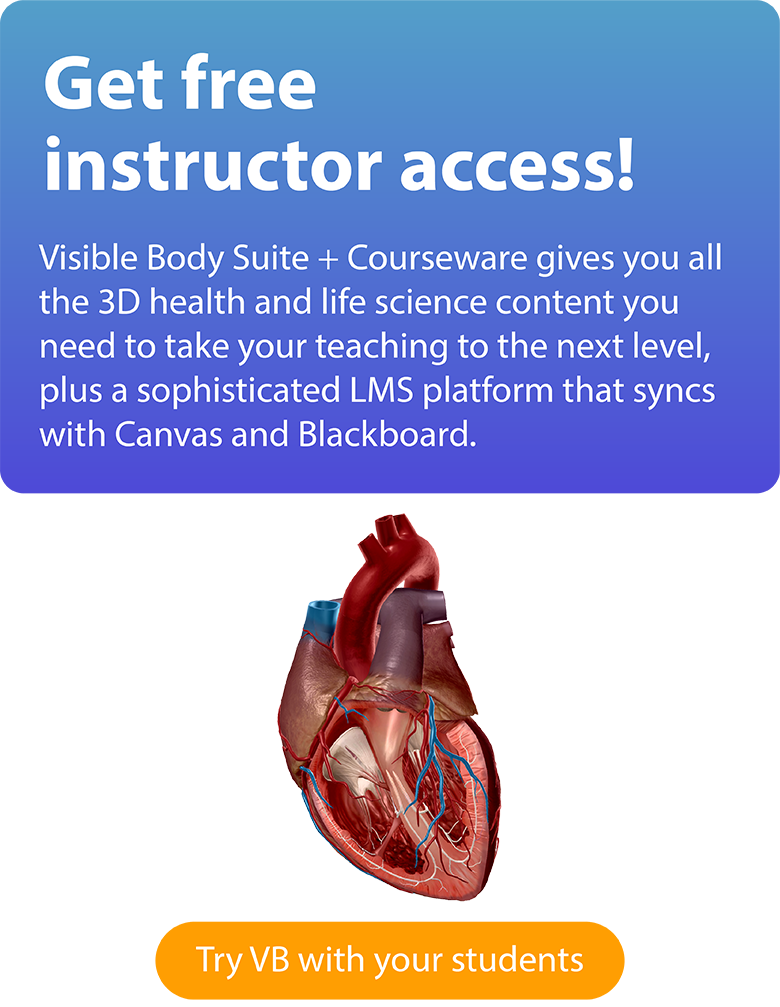Posted on 7/18/25 by Sarah Boudreau
Hybrid classes are here to stay—they give students the flexibility and independence they need. Instructors all over the world have found that Visible Body Courseware works like a charm in their hybrid life science classrooms!
Courseware allows instructors to leverage a comprehensive library of 3D and 2D content in the classroom. You can use Courseware as a standalone LMS or integrate it with your institution’s LMS.
In this blog post, we’ll look at some ways Courseware can be used with a hybrid classroom model.


Instructors told us that their students needed more guidance to keep them focused while completing work at home. We listened!
Courseware assignments give students an “on the rails” experience, taking them through a sequence of 3D models, animations, illustrations, histology slides, and quizzes. These assignments combine reading, exploration, and assessment.
Instructions guide students through interacting with the content, so they can get the most out of their lessons. Students can click on any structure to:
Instructors can choose from a library of premade Courseware courses, or they can build their own using premade and made-from-scratch content. The Visible Body team has even prepared lab activity assignments that are ready to be copied to your course.
 An assignment in Courseware.
An assignment in Courseware.
Grades are automatically sent to the Gradebook, which can be synced with Canvas or easily exported to other LMSs.
Students and instructors who use Courseware gain access to Visible Body Suite, a life sciences atlas that covers anatomy and physiology, pathology, and introductory biology content. About 80% of Courseware users use VB Suite as a visual aid in class, and that’s for good reason—VB Suite is the ultimate lecture aid!

GIF from VB Suite.
In VB Suite, you can annotate the models, add structure tags, and dissect structures to walk students through course topics. Navigation tools help you find content—VB Suite is vast, so our team works hard to give instructors all the tools they need to find exactly what they're looking for.
Does your classroom have an Anatomage Table, ClearTouch panel, or another kind of interactive panel? Since it’s a browser-based app, VB Suite can be run on most interactive panels, and students can work in teams to complete labs and quizzes on the panel.

VB Suite on a ClearTouch panel.
QR codes are another fun way to bridge the gap between pen-and-paper labs and 3D models. It takes a couple clicks to generate a QR code, and students can scan the code using their phones or tablets to access the view, Flashcard, or Tour. QR codes can also be used in conjunction with plastic models!
With Visible Body Courseware, students can take the anatomy lab home with them. Anatomy information is not just confined to a textbook; it’s a tactile experience as students use their visuospatial skills to explore in 3D.
They can learn at home with the same content from the classroom, and with the VB Suite mobile app, they can even learn on the go.
For example, let’s look at Flashcards. You can use Flashcards as a review tool in class, and then assign them to your students in Courseware or provide a QR code they can use to access the Flashcard Deck. Once it’s saved to their user accounts, students can use the Deck to study on their computers or from anywhere with the VB Suite mobile app!

Flashcard using a cross-section in VB Suite.
If you are interested in exploring Courseware for the first time, you can request a free instructor trial here.
Want to read more? Check out these blog posts!
When you select "Subscribe" you will start receiving our email newsletter. Use the links at the bottom of any email to manage the type of emails you receive or to unsubscribe. See our privacy policy for additional details.
©2026 Visible Body, a division of Cengage Learning